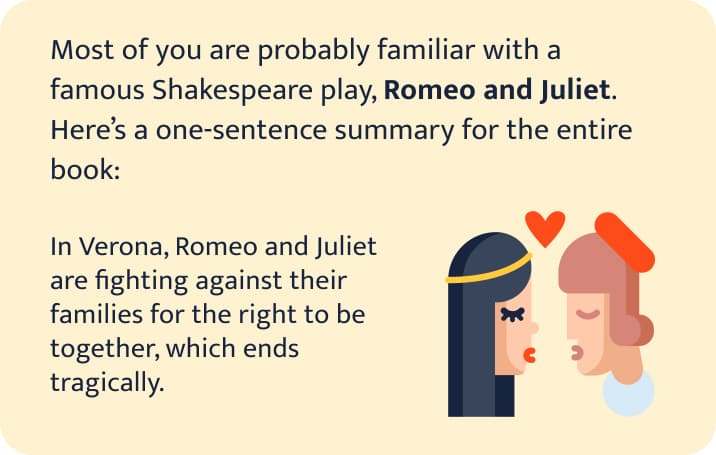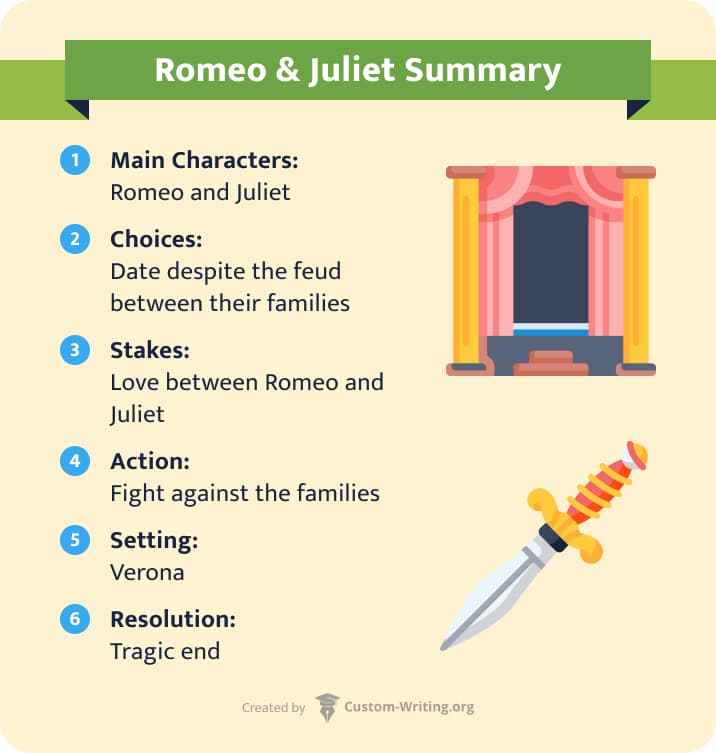Free Story Summarizer
In order to check your reading comprehension, instructors may ask you to retell some sort of fiction story. Sometimes, it may be tricky, especially when the plot is filled with intricacies and crucial details. Besides, you won't always have time to read it in full. Fortunately, our story summarizer can assist you with everything fiction-related.
Have you ever wondered, "Can someone summarize a story for me?" Well, now someone can. Our tool will deconstruct any tale, chapter, or novella you want. Then, the story summary generator will put all the key pieces back together, creating a comprehensive synopsis for you. In the meantime, if you're interested, you can check our article. Here, our experts have explained how to retell a story and what its components are.
⭐️ Story Summary Generator: the Benefits
| 🧑🎓️ Made for students | This story summarizer is designed for educational purposes. |
|---|---|
| 🔢 Easy to use | Paste the text, follow the prompts, and get the result! |
| 🤑 No hidden payments | No need to pay or sign up with this story summarizer. |
| 🕹 Tunable | Choose the desired length of your summary. |
A story summary generator by Custom Writing is a valuable tool for crafting literary analysis essays. With it, you can quickly get a concise overview of a literary work. You can use the instrument to effectively grasp the essence of the piece under scrutiny and to speed up the process of writing your analysis. Moreover, adjust the length of the summary to match the requirements of your paper. However, well-written literary analysis essays go far beyond mere summarizing. They aim to explore the deeper meanings, themes, symbolism, and techniques used in a text—tasks that require a lot of time and effort. If you need support with your literary analysis or another similar assignment, consider using our analytical essay writing service. Our specialists are ready to assist you with your task, help you formulate meaningful arguments, and select the most convincing evidence to impress your audience.
📚 How to Generate a Story Summary
To summarize a story, you need to know how the story works. In other words, you should clearly understand its organization and purpose. In the section below, you will see everything you need to know about plot structure to summarize a story for yourself without loss.
A standard plot consists of the six story elements below.
-
Exposition
It is a starting point of a story where an author provides a general background. Here, the reader first meets the main characters and determines the settings. There are no unexpected plot twists or events in the exposition. It contains only general information and day-to-day actions.
-
Inciting incident
This is a crucial element of a story since it launches the main action. Usually, it is an event that significantly impacts the main character’s life. A proper inciting incident should engage the reader and provoke interest in them.
-
Rising action
It begins right after the inciting incident and keeps the reader in tonus till the climax of the story. The more the rising action progresses, the more tension occurs, and the more engaged the reader becomes. The key aim is to let characters make choices and react to the events.
-
Climax
Here comes the most intense moment of the story. It is the turning point and the peak of tension. It should be very dynamic and leave a strong impression on the audience by solving the primary conflict. Usually, after the climax, the readers are not sure what direction the plot will go.
-
Falling action
Everything that happens just after the climax relates to the falling action. This story element is responsible for deescalating tension and giving the characters a moment to breathe. Here, characters reflect on what has happened to them and move closer to the end.
-
Resolution
This one is the final element of the story that resolves all the conflicts left. It should tie together all the threads and give the characters and the reader a sense of closure.
All of these six elements are crucial for any story. Thus, you should keep all of them to generate a good story summary.
👩🏫 How to Summarize a Story in One Sentence
We bet everyone had seen the sign TL;DR before or after the story posted online. It announces a short summary for those who do not want to read the entire text. Such synopses generally consist of one or two sentences.

In the modern world, the flow of information is very massive from all sides. Thus, it becomes handy to shorten your text. In this section, we will tell you how you can summarize a story in one sentence.
So, to make a story summary, you should highlight and mention the following items:
- Main characters. Figure out the central characters in the narrative and include them in your summary. If the story is overwhelmed with people, don’t try to list all of them. Mention only those who play a crucial role in the plot development.
- Goal or choice. Briefly tell about the main characters’ aims, conflicts they face, or choices they make. You don’t need to include all of these elements. Just decide which ones are the most suitable for the summary.
- Stakes. Stakes may be implied if there is something that the main characters are fighting for. For instance, the King might fight for his daughter’s life. In this case, the stake would be the life of his child.
- Action. We can consider actions everything the main characters do to achieve their goal. Don’t try to retell the entire book here. Highlight one or two key actions and mention them in your summary.
- Setting. While summarizing, address the location where the story takes place. If the events happen in multiple areas, don’t mention all of them. Just try to come up with a broader location, if possible. For example, you can say the palace instead of listing every room described in the book.
- Resolution (if needed). You can also tell how the story ends in your summary. But think twice. Do you really need to reveal the ending? Or maybe it’s better to keep the conclusion a secret for possible readers?

Thanks for reading the article. We hope that both our explanations and story summarizer were helpful for you.
Updated: